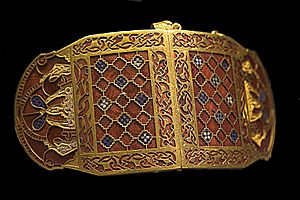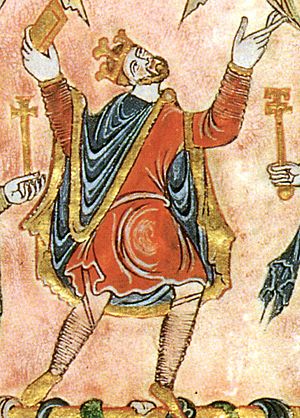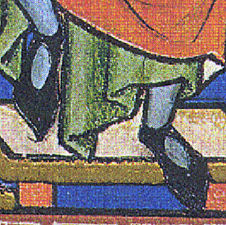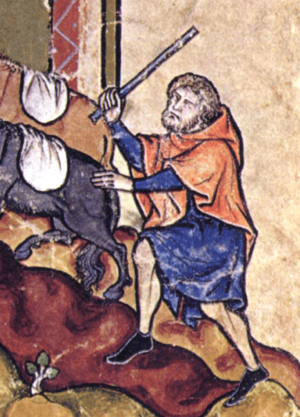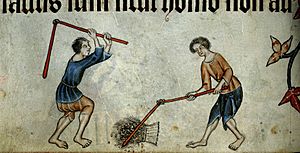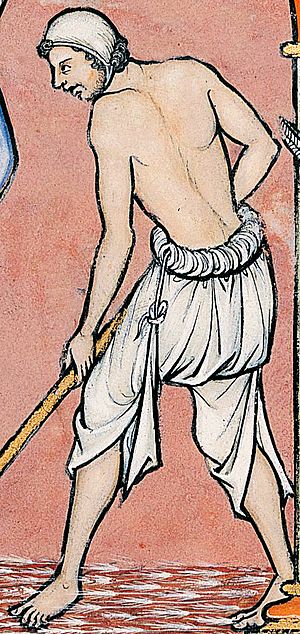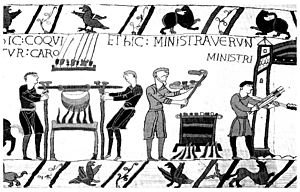English medieval clothing facts for kids
The Medieval period in England lasted from about AD 410 to 1485. This was a long time, and many different groups lived in England, like the Anglo-Saxons, Anglo-Danes, Normans, and Britons. Their clothes changed a lot over these years. What people wore also depended on if they were rich or poor, and if they were a man or a woman.
In the early Middle Ages, clothes were simple. They mostly kept people warm and covered. As time went on, people learned new ways to make fabrics. They also traded more with other countries. This meant clothes became more fancy and detailed. Even people who weren't super rich started to wear nicer things. Clothes were very expensive back then. Most people, especially those with less money, had only a few outfits. There were even laws about what different social classes could wear!
Contents
Medieval Fashion for Women
Early Styles (400s-600s)
In the early Anglo-Saxon times, women wore a long dress that looked like a peplos. This dress was pulled up to the armpits. They wore it over another dress with sleeves. Brooches fastened the dress at the shoulders. Women might have worn a belt, hanging tools or personal items from it.
People probably used animal furs and fleeces to line clothes. They also made warm outer garments from them. A simple poncho could be made from sheep or cattle skins. It would have a neck opening for the head.
We don't have much proof of shoes from this time. Pictures from Anglo-Saxon books show farmers working barefoot. This might mean that shoes were not common until later.
Changing Looks (600s-800s)
Women's fashion started to change in the late 500s. These changes spread from Kent to other areas. They showed less influence from Northern Europe. Instead, styles from the Frankish Kingdom and the Byzantine Empire became more popular. People also started to like Roman culture again.
Linen fabric was used more often for clothes and undergarments. We don't know for sure if women wore leggings or stockings. But it is very likely they covered their legs during this time.
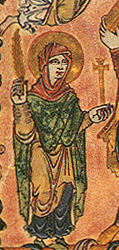
Later Styles (900s-1000s)
Women usually wore a sleeveless outer garment. Sometimes it had a hood. If there was a hood, it was either a scarf wrapped around the head. Or it was a separate head covering with a face opening. This hooded style might have come from Near Eastern art.
Art from this time shows women in long, fitted gowns. These gowns often had a clear border, sometimes in a different color. Arms were usually covered. Sleeves were often straight but flared a little at the end. Braids or embroidery often decorated the sleeves. By the 1000s, many sleeve styles were popular.
The belts from earlier times, with tools hanging from them, went out of style. Women wore simple ankle shoes and slippers. Old items found by archaeologists show that many shoe styles were available.
New Fashions (1100s-1300s)
Around 1300, rich women's gowns became tighter. They also had lower necklines. Clothes were worn in layers. These layers were fitted closely to the body. The surcoat became popular around this time. By the late 1300s, the gown was the main outer garment.
Basic clothes now included a smock, hose (stockings), a kirtle (a type of dress), a gown, a belt, a surcoat, a girdle, a cape, a hood, and a bonnet. Rich women used fancy fabrics like silk and fine linen. Poorer women used wool and rougher linen. The skirt was also developed then. Head coverings, like the tall hennin, became very important.
More fancy fabrics were brought into England. But clothes were still very expensive. Most women owned only a few items of clothing.
Religious Clothing
Until the 1500s, religious women like nuns wore a special outfit called a habit. It had a tunic held with a belt. Over the tunic, they wore a scapular, which was a long, narrow cloth. Their hair was always covered with a hood or a veil and a wimple. Covering their hair showed modesty. This habit showed the ideas of their religious group, like being modest and pure. It also helped tell different religious groups apart.
Medieval Fashion for Men
Early Styles (400s-600s)
Common Clothes
Early Anglo-Saxon men, rich or poor, wore a cloak, tunic, trousers, leggings, and other items. The short, fur-lined cloak had the fur on the inside for warmth. Woolen cloaks were also common. A single brooch usually fastened the cloak. Less wealthy people wore simple woolen cloaks.
The tunic reached between the hip and the knee. It had long or short sleeves. Tunics were pulled over the head and fit snugly. A belt was usually worn with the tunic. Men often wore several tunics at once. The bottom one acted like a shirt.
Trousers were ankle-length. They were worn under a short tunic or with a small cloak. If they were loose, the extra fabric bunched around the waist. Garters or leggings were worn with narrow trousers. Belts held the trousers in place.
Leggings were worn in pairs for extra leg protection. One type was made of woven fabric or leather. The second was just fabric or leather to tie on the leggings. Poorer people made leggings from old clothes. Richer people had custom-made ones. Very rich people sometimes wore jewels.
Belts were a must-have, not a luxury. Buckles were common. Belts often had ornaments or tags hanging from them. Everyday tools were also hung from belts. Leather belts were the most common. Fancy belts were worn to be seen. Another belt might hold the trousers under the tunic.
Anglo-Saxons usually covered their feet, unless they were working. Shoes were made of leather and had straps. Hats, hoods, gloves, and mittens were also common.
Middle Styles (600s-900s)
General Clothes
Clothes from the 600s to 800s were similar to earlier times. All classes wore similar items. But differences between social ranks became clearer with fancy clothes. Common items included tunics, cloaks, jackets, pants, and shoes. A linen shirt was worn as an undergarment.
Men usually wore a knee-length tunic over their shirts. It was linen or wool, depending on the season. Tunic sleeves were long and tight. The extra fabric was pushed up the arm, making "rolls." The tunic neck opened, as did the sides. A belt was usually worn. Richer people had fancy collars or borders. Peasants wore plain tunics. Decorations included gold and silver chains, bracelets, and jeweled belts. Nobles wore longer tunics than common people.
A cloak was worn over the tunic. It was fastened with a brooch at the chest or shoulder. Once fastened, it was slipped over the head. The cloak was knee-length and rectangular. Hoods and collars appeared in the 800s. The cloak also started to be held by the same belt as the tunic. The wrap-over coat also appeared. This knee-length coat wrapped around the body. Its sleeves were deep with decorated cuffs. Poorer people had plainer coats.
The waistcoat or jacket also appeared. Rich people had fur jackets. Less costly ones were linen. These jackets were waist-length and had a broad collar.
Trousers became shorter, reaching mid-thigh. Leather stockings met them there. Cloth or leather rounds were worn over the stockings. They started at the ankle and ended below the knee. They were wrapped in "close rolls" or crisscrossed. Socks were worn over stockings. Shoes from this time were black. They opened down the instep and were secured with straps. All classes wore shoes. Common colors were red, blue, and green.
King's Attire
Until the 800s, the king wore ringed armor. This was made of rings sewn onto a leather tunic. The king also carried a shield and a long iron sword.
A square crown and a longer cloak were worn. In the 800s, metal items for the king were engraved. Later, silk was worn by both the king and nobles.
Military Clothing
Well-armed Anglo-Saxon soldiers wore wrap-over coats. These looked like chain mail. Their sleeves were narrow at the wrists. They were often decorated with flowers or plants. Commanders had fancy, wide belts. Pouches were attached to carry weapons. In the 800s and 900s, military clothes were similar to everyday clothes. The only changes were short linen tunics with metal collars. Soldiers also added a sword, spear, shield, and helmet. Weapons and gear were highly decorated.
Clergy Clothing
The clergy (church leaders) in the 800s and 900s dressed like regular people. This was true except when they led mass. From the late 700s, clergy were not allowed to wear bright colors or expensive fabrics. Their twill cloaks were usually shorter than others. They reached just below the waist. They also wore linen stockings.
Later Styles (1000s)
General Clothes
In the 1000s, shorter tunics became popular. Shorter hairstyles and beards were also in fashion. Piercings and golden bracelets became trendy for men. Men still wore tunics, cloaks, and trousers, which were similar to earlier ones. Coifs, which were flat, round caps, became common head coverings. Long stockings with feet were in style. Leg bandages and shoes were still worn. Short boots, reaching only the ankle, were introduced later in the century. Pointed-toe pigaches also became popular.
Military Clothing
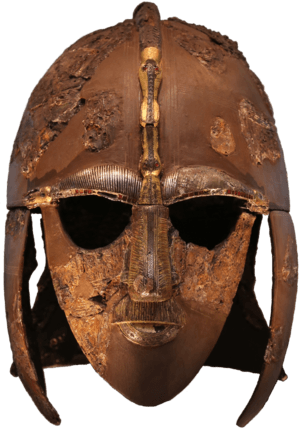
Military clothes were regular clothes with added items. These additions depended on a soldier's rank. They included a spear, ax, sword, bow, shield, steel cap, helmet, an iron coat, or a linen tunic. Soldiers carried round or crescent-shaped shields, usually painted red. Higher-ranking officers decorated their swords. Later in the century, armor was made of leather. Weapons became lighter. Heavy mail tunics were replaced by new leather armor. This armor had overlapping flaps, cut like scales. Each flap was dyed a different color.
Later in the century, warriors shaved their heads to look like clergy. This was to confuse foreign spies. The cowl, covered in rings, appeared. It was worn under the helmet, which now had a nose piece. The ringed, knee-length tunic was split in the front and back for easier riding. Trousers became shorter. "Mascled armor" began to replace traditional ringed armor. These new iron pieces looked like mesh or nets. A "square pectoral" was added to the chest for extra protection. It was quilted or covered with rings. A yellow border was added to the pectorals, sleeves, and skirts. Shields had two new straps. One looped around the arm, and the other around the neck. This let the soldier use both hands.
Clergy Clothing
The clergy in the 1000s had shaved heads. They wore bonnets that were slightly sunken in the center. Other clothes included the chasuble, a church robe, and dalmatics, a tunic with bell-shaped sleeves. The pastoral staff was usually plain.
Later Styles (1100s)
General Clothes
The 1100s brought changes to everyday clothes in England. The tunic was now tight-fitting with a long skirt. It had a slit up the front to the thigh. Sleeves were tight but bell-shaped at the wrist. Or the lower part hung down and could be rolled up. Peasants wore shorter tunics with simple sleeves. The tunic could be worn with or without a belt, which now carried the sword. Necklines were diagonal or horizontal. The super tunic was sometimes worn alone. Its sleeves had "pendulous cuffs" or were loose and elbow-length. The super tunic was sometimes lined with fur.
The cloak and mantle (a loose cape) were fastened with a brooch or clasp. For the rich, the cloak was lined with fur. For all other classes, the cloak was hooded and made of animal hide, with the hair facing out.
Later Styles (1200s)
General Clothes
In the early 1200s, linen underpants were worn. They were shortened to the knee later in the century. Short stockings ended below the knee. Longer stockings reached mid-thigh. They were shaped to fit the leg. Stockings were tied to a belt to stay in place. Some stockings had stirrups or no feet. Hosiery was made of wool or leather. A thin leather sole was sometimes added so shoes weren't needed. Leg wear was often brightly colored, and stripes were popular.
All men wore shoes or boots in the 1200s. Shoes were open over the foot and fastened at the ankle with a strap. Rich people had decorated shoes. Different shoe styles appeared. Some were high around the ankle and slit down the sides. Others were laced or had short tops but were high behind the heel. Boots were mid-calf or knee-length. They laced down the front or inside. Boots were often brightly colored and had "turn over tops." Shorter, pointed-toe boots were also worn. Boots were made of cow or ox leather, cloth, fish skin, or silk for the wealthy.
Separate hoods also appeared. They were loose with a pointed cowl. They were attached to a robe that reached the shoulders. The cape was usually one piece of material. Pointed caps, small round caps, or soft caps like berets were worn. Travelers wore hats with large brims over their hoods. Small hats with round crowns were also worn. The coif, a close-fitting linen bonnet, was worn often. It covered the ears and tied under the chin. It could be worn with other hats or hoods.
Accessories became more decorated. Belts became fancier. Wallets and purses were hung from belts. Later, they were hidden under the tunic. Gloves became fashionable for nobles. Rings, brooches, buckles, clasps, and gold or silver ornaments were worn by the rich. Wool, linen, silk, and leather were still used. Leather was used by peasants for tunics and cloaks, with the hair facing out. Clothes were also embroidered.
Men still wore short and long tunics with a belt. But the front slit was removed. A new style had sleeves and body cut from one piece of material. A wide armhole extended to the waist. Sleeves narrowed at the wrist. The super tunic was still worn by less fashionable people and lower classes.
Five new super tunic styles were introduced. One had front and back panels from shoulders to calf. They were sewn or clasped at the waist. The neck opening was large. A belt was not usually worn. The second style was fuller and hung in folds. Sleeves gathered at the shoulders and extended past the hands. A slit in the upper arm allowed movement. This garment was pulled over the head, often with a hood. The third style was looser. Sleeves reached below the elbow or were short and wide. A buckled belt was optional. The fourth super tunic, or garnache, was knee-length. The material was wide at the shoulders, creating cape-like sleeves. The sides could be clasped, sewn, or left open. It was usually beltless. The last style was sleeveless and worn with a belt. Red, Irish cloth was popular for cloaks and hoods.
Fitchets, like modern pockets, appeared. Vertical slits were cut in the super tunic to reach a purse or keys on the belt.
Men's headwear included hoods, sometimes buttoned. Stalked round caps and large-brimmed traveling hats were still seen. New hats had round brims turned up at the back. Hats with round crowns also appeared. The coif continued to be worn much more often.
Cloaks, mantles, and stockings stayed the same. Stockings were sometimes tied below the knee with narrow strips. Leg bandages became popular for nobles. They criss-crossed above the knee.
Shoes were custom-made for each foot. Most were plain and closed around the ankle. They laced or buckled on the inside. Other shoes exposed the top of the foot. Boots were briefly colored at the top, looser, and barely reached the calf. Boots were also "turned over a little at the top."
Men's accessories were similar to the 1000s. Gloves were worn by nobles. They could be long (to the elbow) or short (wrist-length). They started to be decorated with gold embroidery. By the end of the century, more people wore gloves. They were decorated with silver or gilded buttons. Long hair and neatly trimmed beards were in style for men.
Later Styles (1300s)
General Clothes
Men's clothes in the 1300s were much more fitted. Many standard items changed into new garments with different names. Loose clothes, like the tunic and super tunic, were still worn by lower classes. These loose garments had a front slit and sleeves. They were worn with a belt. They could also be shortened to the hip.
The gipon, also called a pourpoint or doublet, appeared in the 1300s. It replaced the tunic. It was knee-length and close-fitting. The gipon had no folds or gathers. Its sleeves were long and tight. The neck was low. The top part was padded. It was buttoned or laced down the front. For lower classes, it was only buttoned to the waist. The gipon was worn over a shirt. If worn with an outer garment, no belt was used. By the end of the century, the gipon was shortened to above mid-thigh. It was worn with a belt at hip level.
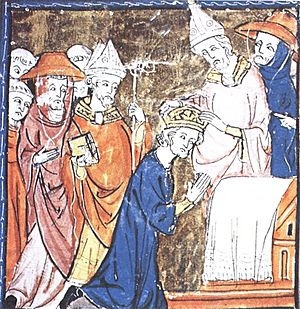
The main outer garment was the cote-hardie. It replaced the super tunic. This new, low-necked, knee-length item was tight-fitting. It buttoned or laced down the front to the waist. Then it flared into a full skirt that was open in the front. The cote-hardie's sleeves were complex. They extended to the elbow in front and hung in flaps in back. Sleeves were decorated. A belt was worn with this new garment. Less wealthy people wore looser cote-hardies. They did not fasten in the front. Instead, they were one piece and pulled over the head. Cloaks and capes were still worn outdoors and did not change much.
Men's stockings in the 1300s were longer. They were tied to the upper leg, hidden under the skirt. Shorter stockings were tied to garters with wool or linen strips. Shorter boots and shoes also became popular. Woolen soles and straps were added to shoes.
The hood was still worn by men. But its shape changed. The pointed cowl was lengthened into a long streamer. From this, another head-dress was made. It looked like a turban with a flap. Stalked caps remained popular. Small hats with close, turned-up brims appeared. Towards the end of the century, men started putting feathers in their hats.
Gloves became common among all social classes. Even working-class people wore them. For this class, gloves often had only a thumb and two sections for the fingers.
Clothing and Social Class
In the Middle Ages, people's clothes clearly showed their social class. Poorer people did not have the same clothes as nobles. Men and women working in fields often went barefoot. Rich and middle-class women wore three layers of clothes. The third layer was often a surcoat, bliaut, or cotehardie. These were often fancy, with fur or silk and detailed designs. Because fabric was so expensive, working-class people rarely wore this third garment.
Fancy headwear was another sign of the upper classes. These could have wires, flowing fabric, and pointed caps. Again, the poor could not afford these. Instead, they wore simple cloth veils called wimples. These draped over the head, around the neck, and up to the chin. Working women wore ankle-length dresses. Men wore short tunics and breeches. The longer a garment was, the higher a person's status. Laws from 1327 said that a servant could not use more than 2.5 yards of fabric for a short gown. They could use 3 yards for a long one. Servants usually did not wear cloaks. Nobles wore cloaks to show they were different from common people.
Most peasant women wove their own fabric and made their own clothes. Wealthy people could afford tailors, furriers, and embroiderers. The richest, like royalty, had these craftspeople working for them.
Social status was very important in the Middle Ages. Clothing showed this idea. For example, red and purple colors were important for royalty. These colors were saved for Kings and Princes. They showed luxury and wealth. Medieval sumptuary laws, or "acts of apparel," controlled what people could wear. These laws made the differences between classes clear. For example, a law from 1363 said that wives of farmers and craftspeople could not wear silk veils. But higher-status groups could wear any imported items they wanted. This showed the clear division between rich and poor.
The laws specifically said that a man should dress according to the class he was born into. The laws described what clothes to wear. They also clearly listed how classes were ranked. Kings and royalty were at the top, and servants were at the bottom. Most of these lists did not include all groups. They mostly focused on the upper and middle classes. Lower classes were often left out. This was because the middle class was thought to be most likely to break the clothing laws. They were supposedly influenced by social pressures. Lower-class people could not afford to dress like a higher rank, even if they wanted to.
Fabrics Used for Clothes
The most common fabric was wool. Wool varied in texture and quality. This depended on the type of sheep it came from. Poor people used very coarse, undyed wool. Rich people used very fine wool with designs and colors. Linen and hemp were other fabrics used. Lower classes often used them for undergarments and head coverings.
Silk was a popular material for the wealthy. It was brought from Asia. After the Crusades, fabrics like damasks, velvets, and satin came to England. Samite also arrived. Animal skins were used too. "Sheep-skin cloaks" were worn in winter to keep out cold and rain. Leather was used for shoes, belts, gloves, and armor.
Middle-class people could usually afford to dye their wool blue and green. The wealthy could add fancy designs to their clothes. They also dyed them red and black, which were expensive colors. Purple was a color for royalty. It was saved for kings or religious leaders like the pope.
See also
- England
- 1100–1200 in fashion
- 1200–1300 in fashion
- 1300–1400 in fashion
- Anglo-Saxon dress
- History of clothing and textiles
- Early Middle Ages
- High Middle Ages
- Early medieval European dress
- Anglo-Saxon brooches
|


